Do you have a question about the Kaco blueplanet gridsave 92.0 TL3 and is the answer not in the manual?
Information about the manual's origin, validity, and related documents.
Links to additional technical data, protocols, and software documentation.
Explains symbols used for hazards and instructions.
Details on how to identify the product using the name plate.
Information about warning stickers affixed to the device and their meaning.
Specifies the qualifications required for personnel performing tasks described in the manual.
Defines the intended use of the device and potential hazards from improper use.
Lists integrated monitoring and protection functions of the device.
Explains how the device operates and its communication requirements.
Visual overview of the device, including electrical functions and interfaces.
Illustrates the system configuration with the device and its connections.
Detailed electrical specifications for DC input and AC output levels.
General technical data including efficiency, self-consumption, and interface details.
Specifications related to installation environment, temperature, and protection ratings.
Lists the items included in the delivery and checks to perform.
Provides safety precautions and instructions for transporting the device.
Explains tool codes used for assembly, installation, and maintenance.
Safety warnings and criteria for selecting a suitable installation location.
Safety precautions and steps for unpacking the device and its components.
Instructions and safety warnings for securely mounting the device.
Steps for lifting, installing, and securing the device onto the mount.
Procedure for opening the device after it has been mounted.
Shows connection areas for different device versions (M, L, XL).
Basic conditions and notes for making electrical connections, including supply lines and fuses.
Instructions for preparing and making the AC grid connection.
Safety warnings and procedure for connecting the battery, including variants.
Steps for installing AC and Ethernet surge protection modules.
Procedure for establishing an equipotential bonding connection.
Overview and connection procedures for communication interfaces like Ethernet and RS485.
Procedure for closing and sealing the device's connection area.
Safety precautions and conditions required before commissioning the device.
Describes different methods for initial device start-up and configuration via Wi-Fi, cable, or USB.
Explains the meaning of the device's LEDs and their different operating states.
Overview of the device's graphical user interface for monitoring and configuration.
Details the navigation and configuration options within the device's menu system and web interface.
Steps for connecting and monitoring the device via the network.
Instructions and safety precautions for updating the device's firmware.
How to enable and use Modbus functionality for communication.
Explains the functions of the multi-function buttons and LED indicators for operation.
Explanation of reactive power control and its role in voltage stability.
Methods for regulating active power for grid stability and load flow management.
Device capabilities for maintaining grid connection during voltage disturbances.
Functions that support grid stability related to active power, like gradient limitation.
Method for detecting unintended island formation in the grid.
How the device behaves when communication is lost.
Instructions for visually inspecting the device and cables for damage.
Procedures for cleaning the device housing and heat sinks.
Steps for removing the cover and replacing a fan.
Procedure for safely shutting down the device for maintenance.
Instructions for replacing the DC fuse.
Information on identifying and rectifying common faults.
Lists fault messages, their explanations, and LED indicators.
Table of status and fault messages with corresponding actions and troubleshooting steps.
Advice on handling faults not listed in the manual.
Safety warnings and procedure for switching off the device.
Steps for disconnecting AC and DC connections.
Procedure for safely uninstalling the device.
Steps for disassembling the device after it has been uninstalled.
Guidelines for packaging the device for storage or transport.
Recommendations for storing the device to prevent damage.
Environmental precautions and instructions for proper disposal of the device and packaging.
Information on how to contact KACO service and warranty conditions.
Details of the device's compliance with EU directives and standards.






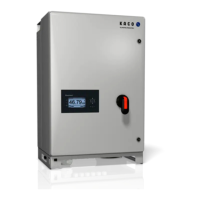
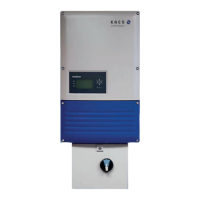
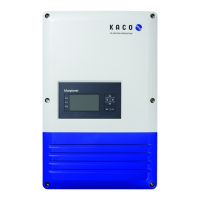
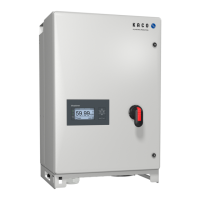
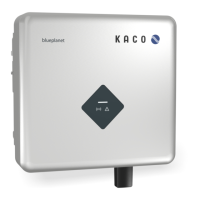
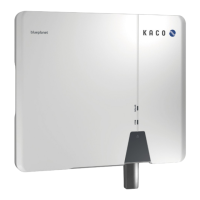
